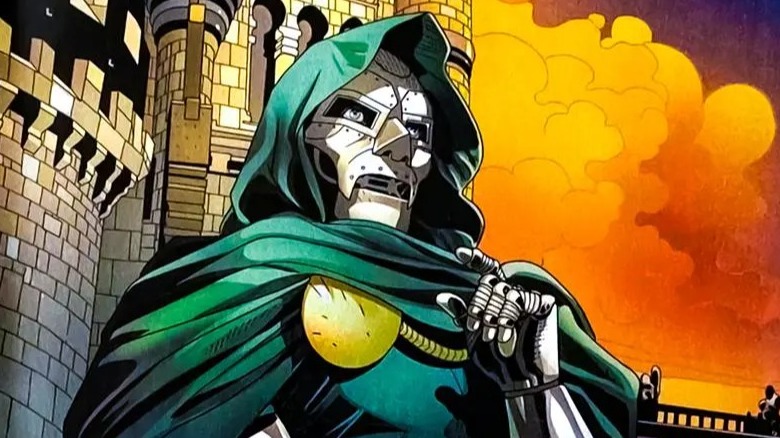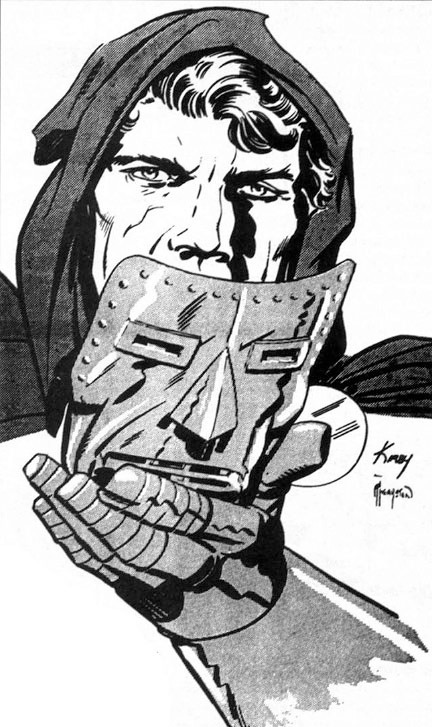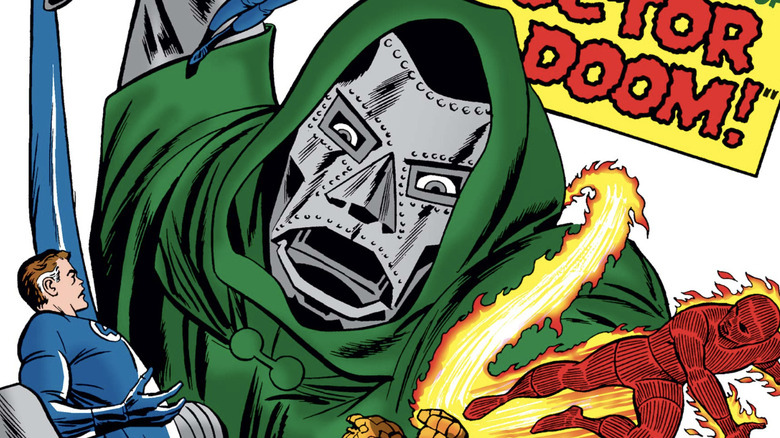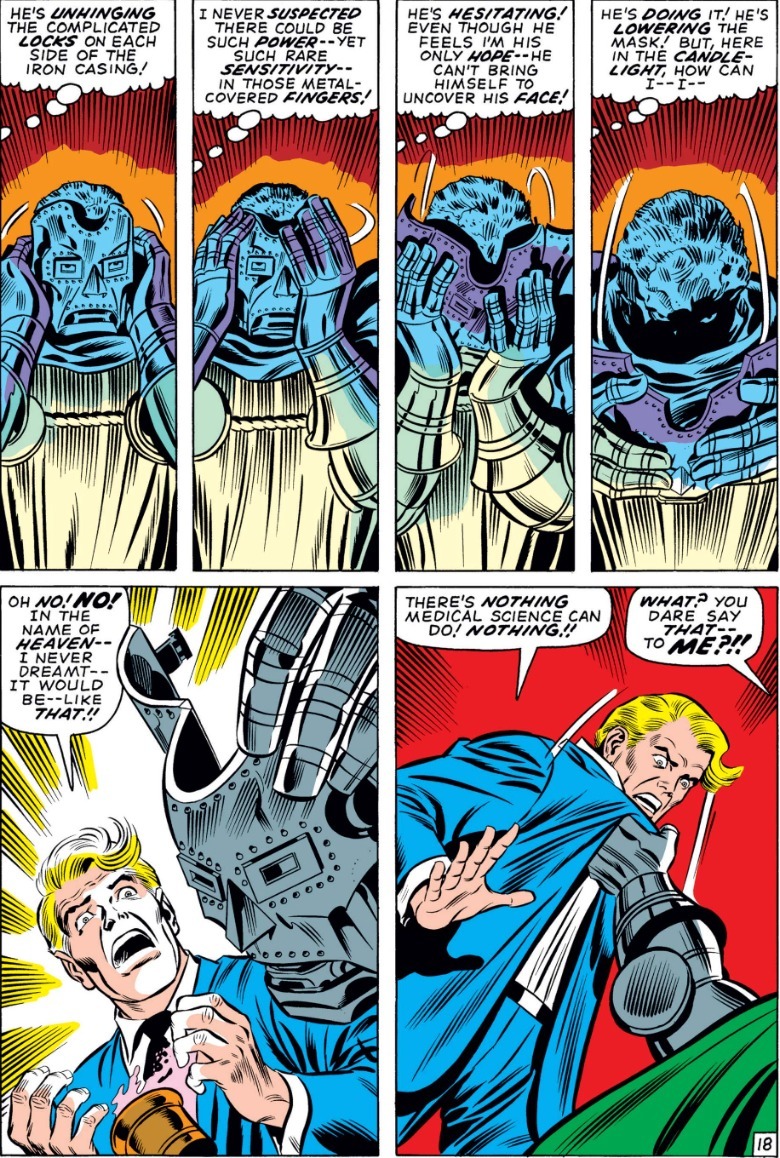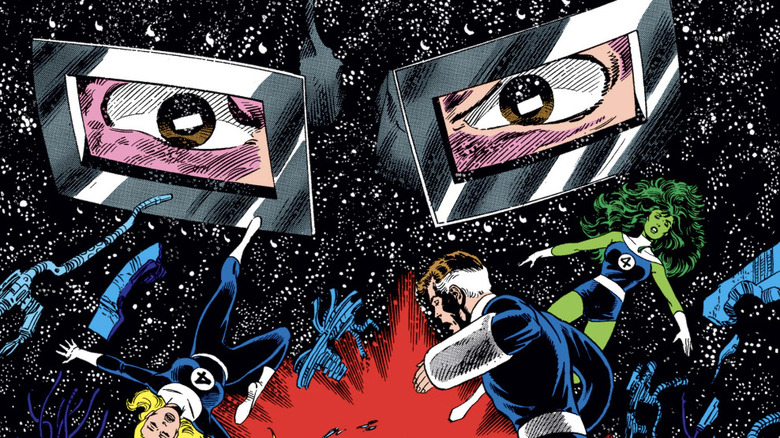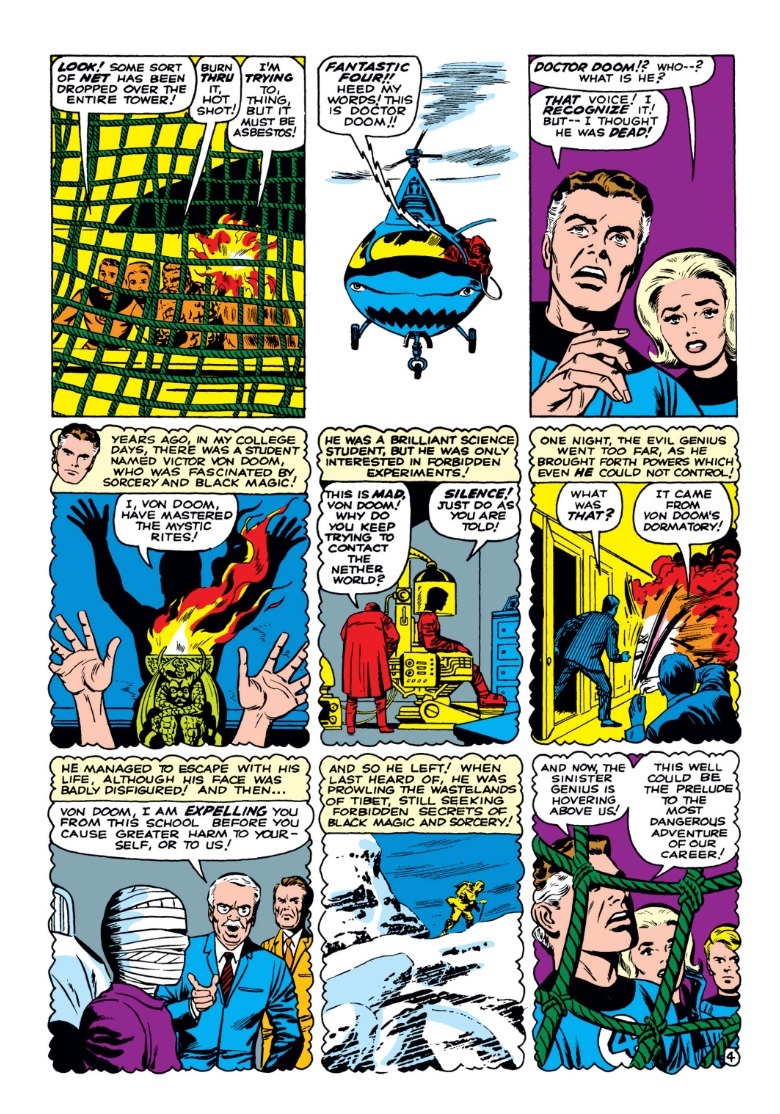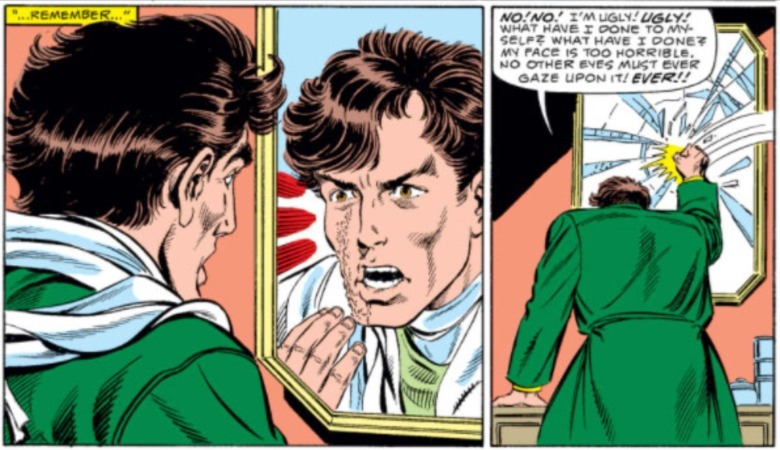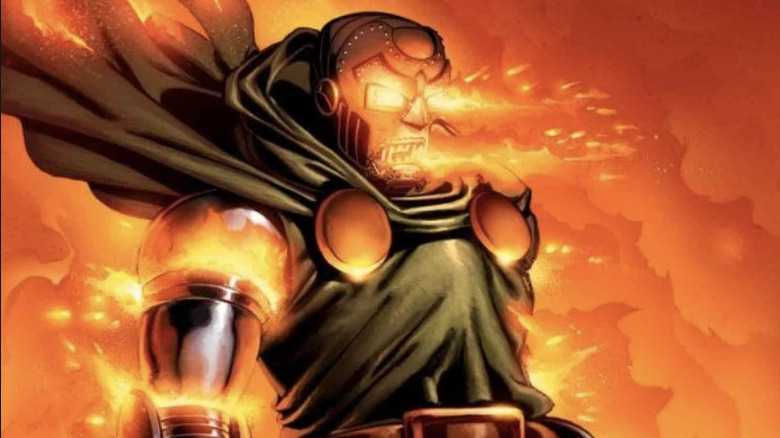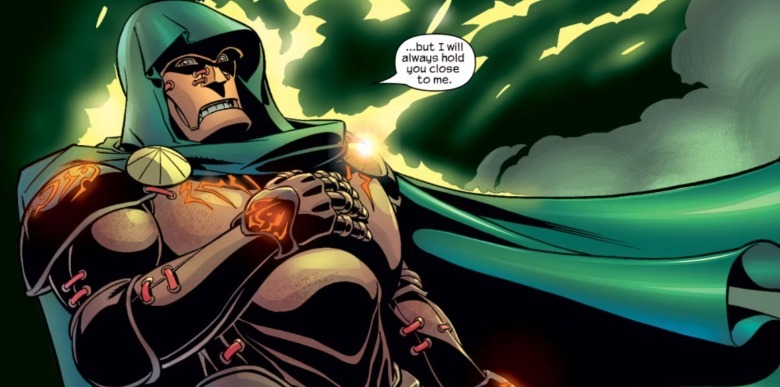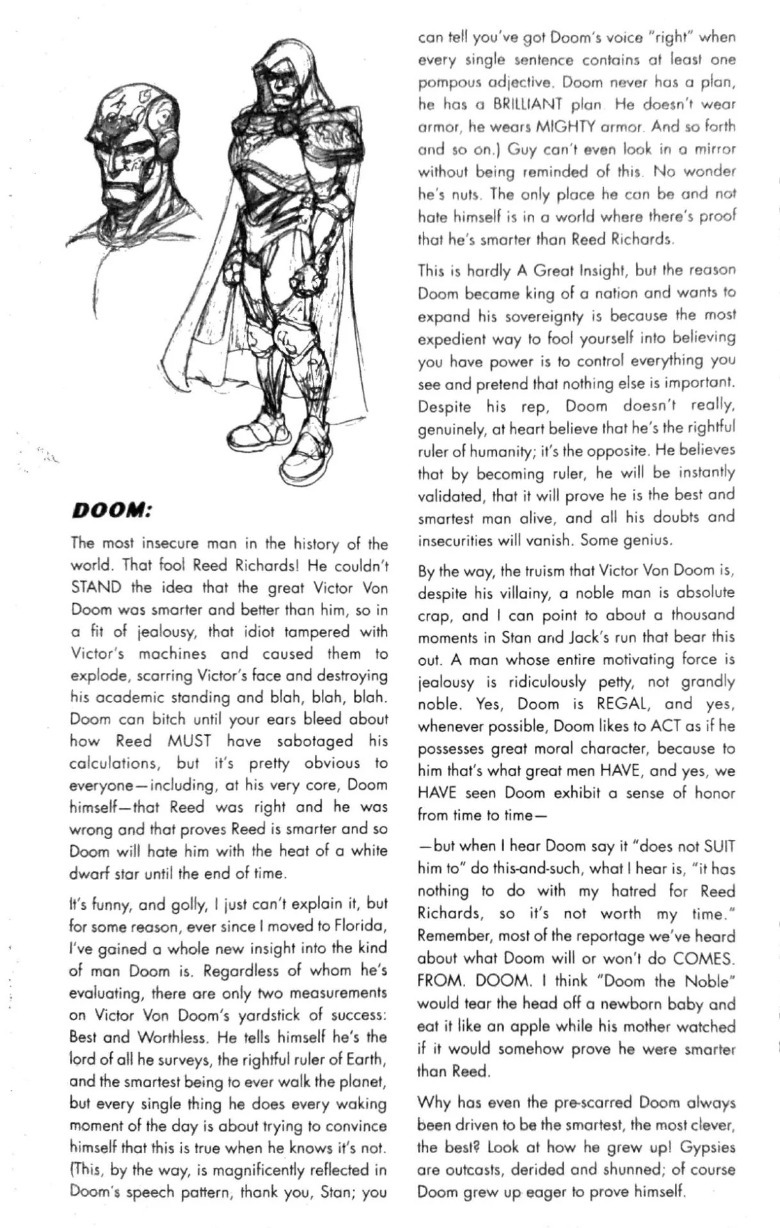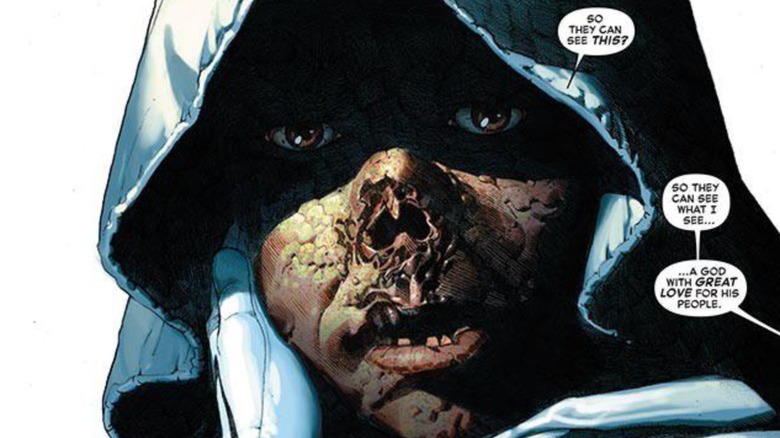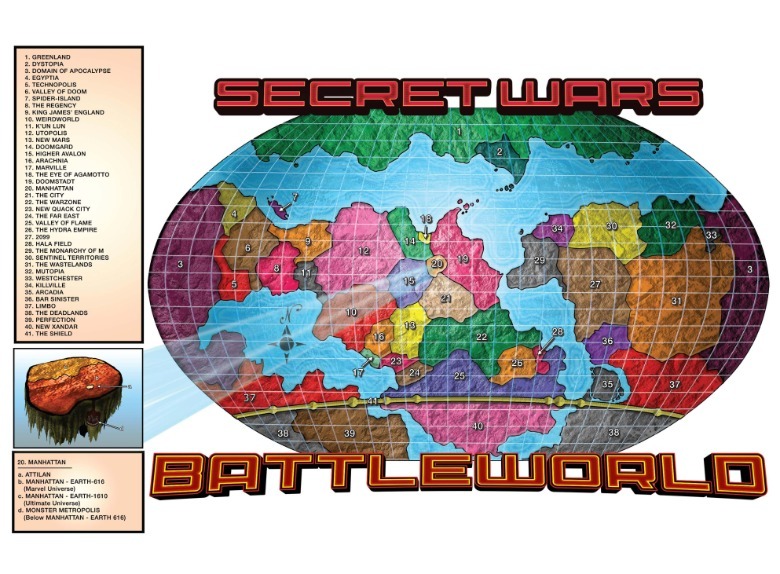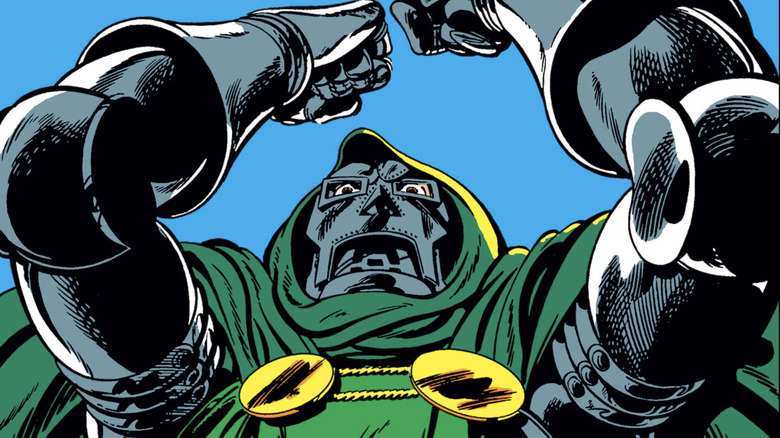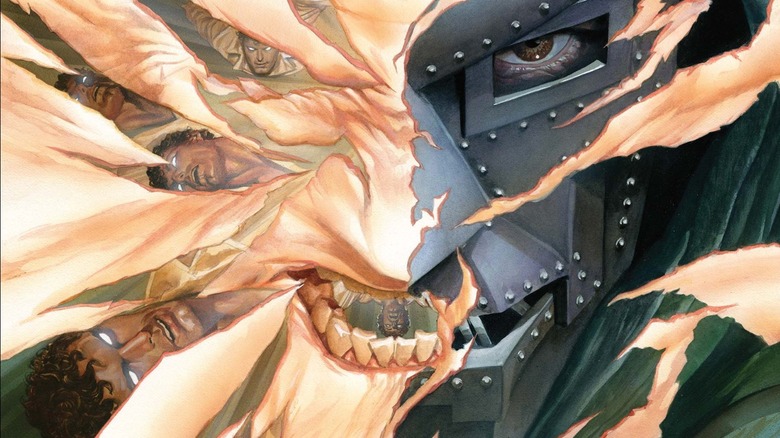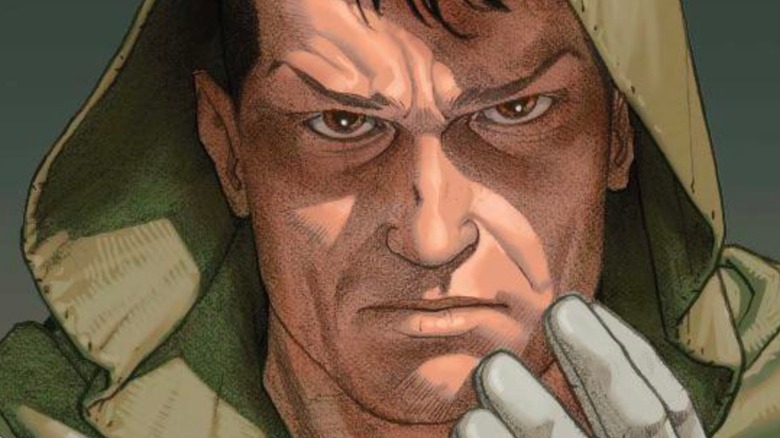Doctor Doom Unmasked: Victor Von Doom's Scarred Face In Marvel Comics, Explained
Doctor Victor Von Doom, archenemy of the Fantastic Four and the greatest villain of Marvel Comics, is making his Marvel Cinematic Universe debut in 2026's "Avengers: Doomsday." In case you've been mercifully offline since San Diego Comic-Con 2024, the MCU's Doom will be played by former Iron Man actor Robert Downey Jr.
I think this is a poor choice for many reasons. One of them is that the film will doubtlessly make a big deal out of Doom sharing the same face as Tony Stark. (I presume there's some multiverse nonsense going on here.) That makes Doom's face central, whereas a big part of Doom's character is that he's not supposed to be seen unmasked. He wears an iron mask because beneath it, his face is heavily scarred. (There's a reason many call Doom the original Darth Vader.)
Doom's physical scars are intertwined with his psychological ones. As a college student, Doom built a machine to visit the "nether realm." (He yearned to contact his mother, Cynthia Von Doom, who had been damned to Hell for practicing witchcraft.) When he tested the machine, it blew up in his face. Insult was literally added to injury because Doom's classmate, a young Reed Richards, had warned him his calculations were slightly off. Doom didn't check them over because of his own arrogance and paid the price.
Doom hates Reed because he blames him for his scarring, telling himself Richards must have sabotaged the machine. Deep down, though, he knows the accident really happened because Reed was right and he was wrong. Doom has to deny this proof someone is smarter than him, just like he denies evidence of his imperfect appearance with the mask. But how imperfect is that?
Legendary artist Jack Kirby, Doom's co-creator, offered this drawing of Doom unmasked:
Wait, you're wondering — that's supposed to be a man with heavy scarring? Look again and you'll notice a slight scar on Doom's right cheek. You may have overlooked it, but Doom didn't.
Does Doctor Doom have a huge scar or a small one?
Speaking at a comic convention in 1985, Kirby explained his intentions with Doom.
The explosion left Doom with only a tiny facial scar. Doom being the egotist he is, however, he can't get past that small imperfection in his appearance. So, he hides his face from himself and others with his iron mask even though most people would hardly even notice his scar to begin with. Doom's fixation on that scar, Kirby noted, is his tragic flaw. He has admirable qualities — intelligence, class, generosity to his subjects in Latveria — but the scar means the devil on his shoulder always wins. In Kirby's own words:
"Behind that steel mask, there's a very handsome guy [...] but there's one thing wrong with [Doom]. He's got a scratch on his chin and he's frustrated [...] without that little scratch, which kind of ruins his whole personality and supplies that lifelong frustration, that's what makes him the villain he is."
It seems that Doom's other co-creator, Stan Lee, did not share Kirby's interpretation. In 1970's "The Mighty Thor" #182 (written by Lee, drawn by John Buscema and John Romita), Doom kidnaps surgeon Donald Blake (Thor in human form) to repair his face. He unmasks himself before Blake, who stands back in horror and says his face is beyond the saving grace of cosmetic surgery.
That split endures between Marvel Comics writers and fans. I doubt every writer who's penned a Doctor Doom story was aware of Kirby's authorial intent. So they would just take the implications of Doom's mask, and the flashbacks depicting his scarring in Lee/Kirby's early "Fantastic Four" comics, at face value. Which side of the split you come down on can depend on how you view Doom's whole character.
John Byrne's Fantastic Four reinvented Doom
In his first appearance, 1962's "Fantastic Four" #5 by Lee/Kirby, Doom was presented as an old schoolmate of Reed's who tampered with the dark arts and got burned.
Doom's full origin only came two years later in "Fantastic Four Annual" #2. This established he was born to a Roma tribe in Latveria, saw both his parents die young, and trained himself into an expert scientist and sorcerer. The issue also added the wrinkle of Reed's warning to Doom. In earlier issues, Doom's vendetta against the Four was vague; he just wanted to prove himself humanity's champion by defeating the world's greatest heroes.
His grudge against Reed finally gave his villainy solid grounding. After his scarring and expulsion, Doom (whose face is only seen wrapped in bandages) stumbles onto monks high in the Himalayas, who forge his armor. Doom flies off, takes Latveria for himself, and the rest is history.
John Byrne, who wrote and drew "Fantastic Four" from 1981 to 1986 (issues #232-293), is the book's most influential author after Lee and Kirby. He retold Doom's origin in "Fantastic Four" #278, with a framing device that Doom's ward Kristoff Vernard is viewing the memories of the presumed dead Doom.
Byrne sticks close to "Fantastic Four Annual" #2, even using some of Lee/Kirby's dialogue and panels verbatim. The big change is that he shows Doom's face after the explosion:
A noticeable scar, bigger than the one Kirby had in mind, but also one that's relatively limited in size. Then, when Doom is having his armor forged, he orders the mask put on his face while it's still hot. That is what scars Doom's entire face. Clearly, Byrne was melding the two interpretations here, and in doing so he underlines Doom's self-destructiveness and Kirby's point. For Doom, any scar makes his face hideous. The grazing on his cheek is tantamount to his face literally melting off, so that's what Doom lets happen. Byrne's origin makes Doom petty and tragic.
Mark Waid thinks Doctor Doom is Marvel's greatest monster
Mark Waid wrote "Fantastic Four" from 2002 to 2005 (first issues #60-70, then the series returned to its original numbering for #500-524.) His major Doctor Doom story, "Unthinkable," is one of the most jaw-dropping Marvel comics ever.
Doom decides that he made a mistake focusing more on science than magic; Reed can always beat Victor at science, but is clueless about the mystic arts because there's no logical explanations for them. To gain the power he would have if he'd concentrated more on sorcery over the years, Doom makes a deal with demons. Their price? Not his soul, but that of his childhood girlfriend's Valeria. Tracking her down and telling her he wants to be with her, Doom sends her to Hell then turns her flayed skin into his new armor.
Unlike some other "Fantastic Four" writers, Waid has no patience for Doom's BS. To prepare to write, Waid penned a "Fantastic Four Manifesto" outlining his thoughts on the book's lead characters. (The manifesto is included in some collected editions of his run.)
In Victor's section, Waid introduces him as "The most insecure man in the history of the world." Doom's protestations about his honor and that the world is rightfully his? "Absolute crap," Waid writes. "A man whose entire motivating force is jealousy is ridiculously petty, not grandly noble." Doom's insatiable need to prove himself superior comes from his humble childhood as part of a marginalized group, Waid writes, and it's turned him into a man who would "tear the head off a newborn baby and eat it like an apple while his mother watched if it would somehow prove he were smarter than Reed."
It's not surprising that Waid subscribes to Kirby's interpretation that Doom only has a small scar. "To claim otherwise is to completely rob from Doom one of the most tragic, most interesting facets of his character," said Waid to Newsarama in 2002.
2015's Secret Wars finally revealed Doctor Doom's true face
The next "Avengers" film after "Doomsday" is subtitled "Secret Wars." This title refers both to the original 1984 "Secret Wars" by Jim Shooter, Mike Zeck, and Bob Layton, and the 2015 book by Jonathan Hickman and Esad Ribic. In both stories, Doom steals godlike power from the cosmic being the Beyonder and rules over other superhumans on the distant planet Battleworld. The original "Secret Wars" is just a toy commercial, frankly. The reimagined one is an actual story and the culmination of Hickman's Marvel Comics epic.
Hickman wrote both "Fantastic Four" (from 2009 to 2012) and "Avengers"/"New Avengers" (from 2012 to 2015). Narratively, "Secret Wars" is the finale of his "Avengers" run. But the core themes and conflict of the story — especially Reed and Doom's feud over who can fix the world better — go back to "Fantastic Four."
During Hickman's "Avengers," universe after universe is being destroyed in events called Incursions. Doom, who knows this is the work of the Beyonder race, is one of many parties working to ensure survival. After the last two worlds collide and shatter, Doom kills the Beyonders and steals their power, forging chunks of the multiverse together into a single planet known as "Battleworld."
Divided into 40 kingdoms, God Emperor Doom rules as an overlord. His throne is built into Yggdrasil, the Norse tree of life that binds reality together. Doom may be a god, but his human faults remain; he ensures there are no Reed Richards variants on Battleworld and takes Sue Storm as his queen.
In issue #3 of "Secret Wars," Doom admits his self-doubts to Sue and removes his mask. Ribic's rendition of Doom's scarred face, still reminding Victor of his imperfections even as he's reached his zenith, better explains why Donald Blake reacted the way he did (insensitive as it would've been either way).
How different Marvel Comics writers approach Doctor Doom
Doom has a reputation among writers and fans as a noble villain. He conquers for the benefit of the ruled and Doom's word, including his promises, are law, he says. How a writer interprets Doom's hidden face generally tells you if they believe in Doom's good side. After all, him having genuine scars makes him more sympathetic than if he's just hung-up on a small scratch.
John Byrne's Doom is no hero — he's a benevolent tyrant. The people of Latveria are comfortable, but not free. In "Fantastic Four" #200 by Marv Wolfman and Keith Pollard, the Four overthrew Doom and put Latverian Prince Zorba back on the throne. Come Byrne's "Fantastic Four" #247 — "This Land Is Mine!" — Doom arrives to retake Latveria and the FF are astonished that his people want him back. Byrne's take is in line with Stan Lee, who said Doom is not a mere criminal (wanting to conquer the world isn't necessarily a chargeable offense, Lee maintained).
Mark Waid, though? He sees Doom as basically Richard Nixon — an insatiable striver who climbed to the top to prove to himself that he deserved to sit there, and who needs the whole world in his palm to fill the emptiness in his heart. Waid's Doom is an unfettered monster whose nobility is a lie. If someone has to constantly shout about their greatness, their genius, and their justness, as Doom does, it's because they're trying to convince themselves. Of course Waid gravitates to the idea that Doom's "deformity" is also untrue.
Jonathan Hickman writes Doctor Doom as an anti-hero
Hickman giving Doom a truly scarred face tracks with his take as well. He writes Doom as someone who could be a good man if he'd only get over his hang-ups about himself and Reed. For this to work, Doom needs to have the psychological hurdle of substantial scarring; a tiny scar makes sense to Doom's internal psychology, but it also makes it harder to see him as someone who could be a hero.
In the climax of "Secret Wars," Doom's godlike posturing melts away and his raw jealousy of Reed resurfaces. Reed has always looked down on Victor and thought he could do better, Doom shouts, and Reed schools him that, no, he knows Victor can be better. Reed even credits Doom for saving what he could of the universe — but he could have done more. Doom didn't, because he was scared he might fall short.
Hickman likes to give characters what they most want and explore how they act once they have it. His "X-Men" relaunch, "House of X/Powers of X," was about Professor X and Magneto coming together to build a mutant utopia. In "Secret Wars," Victor rules all — "Doom" is synonymous with "God" on Battleworld — but he's still unsatisfied with his imperfections and the nagging feeling that Richards could've done it better. He keeps Battleworld as it is not because it was the only option for survival, but because the stasis shielded him like his armor.
Reed (who takes the Beyonders' power) heals Doom's face at the end of "Secret Wars," giving Victor a fresh start to be the better man Reed believed he could be. Victor accepting the gift with joyous laughter is a sign he might just become that better man.
Why doesn't Doom fix his scarred face?
In 2018's "Invincible Iron Man" #600 (written by Brian Michael Bendis), Doom's face is again scarred and it's been super-villain business as usual for him since. But here's a question: Doom is one of the smartest men to ever live (he'd smite you just for qualifying the statement with "one of"), a master of science and sorcery, and somehow there's no way to heal his scars? Even as there's not a second when he doesn't think about them?
In the original "Secret Wars," Doom restores his face once he gets the Beyonder's powers, implying that, yes, Doom needed nothing less than the power of a god to heal his face. In the 2015 "Secret Wars," Doom doesn't, and apparently can't, heal his face, not even with omnipotence.
Christopher Cantwell and Salvador's 2019 "Doctor Doom" series answers in text what Hickman leaves as subtext. In the 10th and final issue, Doom meets an alternate version of himself who healed his face, found love, and built a universe-wide utopia. All it took, this alternate Victor says, is accepting he was never a victim, his grudges weren't worth holding, and that fixing the world was more important than proving he could. Doom would never admit it, but he chooses to keep his face scarred to prove to everyone, himself included, that the world (and especially Reed Richards) wronged him. 616 Doom then proceeds to kill this reformed variant and destroy his entire universe, so, yeah, self-pity is the answer.
The flipside of this story is Chip Zdarsky and Ramón Pérez's "Marvel Two-In-One" #11. It's revealed Reed is friends with a reformed Doom from an alternate universe. That friendship is why Reed still keeps the faith in "his" Victor; he's seen that Doom can walk a righteous path.
The one part of Doom's face still visible through his mask is his eyes. Every Marvel Comics writer and fan has stared into those eyes and seen something different.
